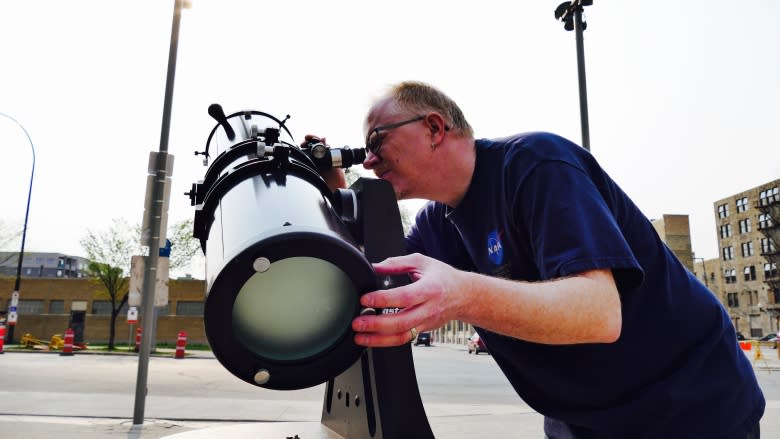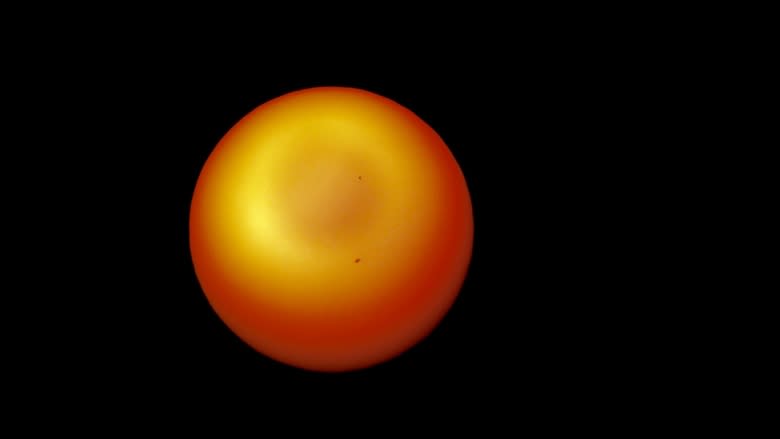Manitoba skywatchers peer up as Mercury crosses surface of sun
Astronomers and amateur skywatchers alike are heading outdoors Monday to catch a glimpse of the transit of Mercury.
The tiny planet is moving across the lower surface of the sun throughout the day, casting its shadow against the white-hot surface of the sun.
Starting at 6:12 a.m. CT Monday, Mercury appeared as a dark spot on the east of the sun. Slowly throughout the day, the planet's orbit will pull it diagonally down and west across the surface of the sun until it fades back into the darkness of space at about 1:42 p.m.
"What's really cool about it is the dot that you see, it's small ... but it's very black — a pure black dot on the bright disc of the sun," said Jennifer West, a PhD candidate in the department of physics and astronomy at the University of Manitoba.
There are at least two viewing events in Winnipeg Monday. Scott Young, an astronomer at the Manitoba Museum Planetarium, is set up behind the museum near the Lily Street and James Avenue intersection giving people a chance to "see the dark side of Mercury" through telescopes.
Meanwhile, members of the Royal Astronomical Society of Canada's (RASC) Winnipeg chapter, along with students and researchers in the department of physics and astronomy at the U of M, will have telescopes open to the public from 8 a.m. to noon on the patio outside Degrees Restaurant at University Centre.
'Clockwork of the heavens'
"It's cool because it's the kind of event that shows us how the solar system is actually moving," said Young, who is also a past-president of RASC.
"It lets us sort of see the clockwork of the heavens unfolding before our eyes. Most of the time we don't actually notice things are moving around at high speeds, but here you can actually see something happening."
Mercury transits the sun about 13 times every 100 years. Historically, these celestial events presented astronomers with opportunities to time transits. This gave astronomers a chance to study the size and shape of planets, along with their orbital speed and distance from the sun, and refine existing theories of how planets move in space.
But then Mercury, as observers on Earth saw it in transit, started to gradually get out of sync with past records. The common understanding of gravity centuries ago couldn't account for anomalies in transit timing, Young said.
"Nobody really knew why until in the early part of the 20th century, Albert Einstein came up with his theory of general relativity. In and amongst that whole complicated theory are a number of essentially correction factors to our old theories," Young said,
"And once you apply relativity to this situation of Mercury going around the sun, everything matches up perfectly.... The fact that the observations now match the theory was really one of the first proofs that Einstein's theory was in fact correct."
'Neat thing to watch'
The science of astronomy has evolved at a rapid rate since then, which makes watching Mercury's transit more about appreciating the show.
"Nowadays it's mostly just out of curiosity and [it's] a neat thing to watch," Young said.
Tracking present-day transit phenomena in our cosmic backyard may be less about collecting hard data at this point, but observing planet transits outside our solar system is still the main method used to discover new, faraway planets.
Careful not to fry your eyeballs
As for anyone in Manitoba looking forward to looking up at the sky Monday; a note of caution.
First, don't bother breaking out that dusty old telescope your grandmother gifted you as a kid — it could seriously damage your peepers.
Based on safety concerns, Young says watching the transit requires the use of specialized equipment that even people with fancy telescopes aren't necessarily likely to have.
"You have to have some kind of special solar filter. It's not just sunglasses — it's a serious piece of optical equipment that can let you look at the sun without frying your eyeballs," Young said.
There are also some fairly straightforward directions online for how to modify binoculars using a filter that can make the transit safe to view from the comfort of your backyard.
If you can't make it to one of the events, Young encourages people to tune into one of the many free streams available online. West added that the forecast is for nice weather, so people on campus should take advantage of the rare opportunity.
Follow Bryce Hoye on Twitter or send your sciency story ideas to bryce.hoye@cbc.ca



